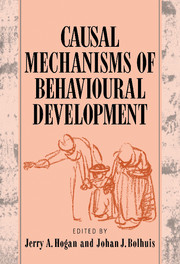Book contents
- Frontmatter
- Contents
- List of contributors
- Foreword: Introducing Jaap Kruijt
- Preface
- Part one Introduction
- Part two Development of perceptual and motor mechanisms
- 3 The neural basis for the acquisition and production of bird song
- 4 Sexual imprinting as a two-stage process
- 5 The influence of social interactions on the development of song and sexual preferences in birds
- 6 Perceptual mechanisms in imprinting and song learning
- 7 The development of action patterns
- Part three Development of behaviour systems
- Part four Development of cognition
- Part five Learning and development
- Author index
- Subject index
7 - The development of action patterns
Published online by Cambridge University Press: 19 January 2010
- Frontmatter
- Contents
- List of contributors
- Foreword: Introducing Jaap Kruijt
- Preface
- Part one Introduction
- Part two Development of perceptual and motor mechanisms
- 3 The neural basis for the acquisition and production of bird song
- 4 Sexual imprinting as a two-stage process
- 5 The influence of social interactions on the development of song and sexual preferences in birds
- 6 Perceptual mechanisms in imprinting and song learning
- 7 The development of action patterns
- Part three Development of behaviour systems
- Part four Development of cognition
- Part five Learning and development
- Author index
- Subject index
Summary
How do action patterns develop in early life? In this chapter, I examine the early development of patterns of action such as walking, hatching, feeding, and grooming. Such behavior patterns I consider to be instinctive or innate. Use of the terms instinct or innate has been strongly criticized by ethologists and comparative psychologists, for essentially two reasons, so I will begin with a few words to justify my use here.
The first criticism traditionally attacked the role of innate as a causal explanation for behavior (e.g. Dewey, 1918; Kuo, 1921; Beach, 1955; Lehrman, 1953, 1970; Hinde, 1968). Kruijt has condensed this criticism succinctly: ‘… for ontogenetic purposes, the term instinctive or innate can be said to be completely empty. No light at all is thrown on the nature of the factors underlying the development of instinctive behavior except for the fact that certain specific factors are not necessary’ (Kruijt, 1971, p. 10); and ‘the term innate does not invite one to ask causal questions about the ontogeny to its final consequences’ (Kruijt, 1964, p. 5).
The second criticism has attacked innate as a classification for behavior. If innate, or instinctive, is meant to refer to behavior that is absolutely predetermined by genotype, independent of experience, and unmodifiable by feedback, then no behavior can be found that qualifies. Instead, concerning this absolute sense of innate, the conclusion has prevailed that there might be said to exist only innate behavioral differences between individuals, if their developmental histories were identical yet their behavior differed (e.g. Jensen, 1961; Hinde, 1968, 1970; Bateson, 1991).
- Type
- Chapter
- Information
- Causal Mechanisms of Behavioural Development , pp. 147 - 180Publisher: Cambridge University PressPrint publication year: 1994
- 10
- Cited by



